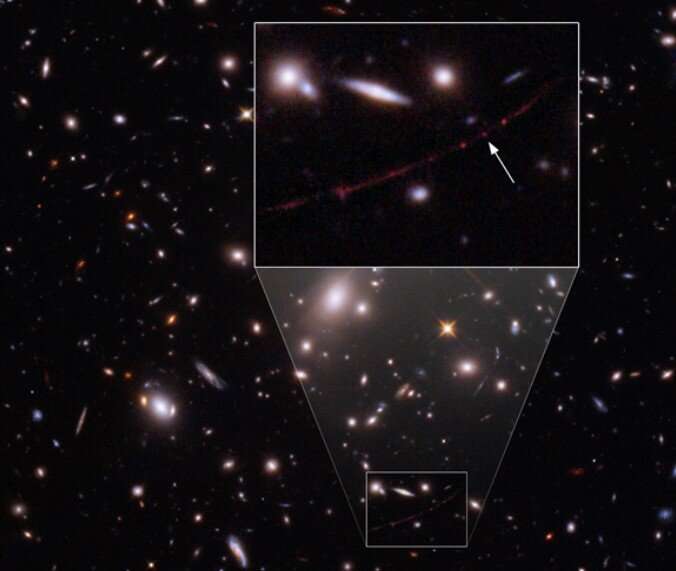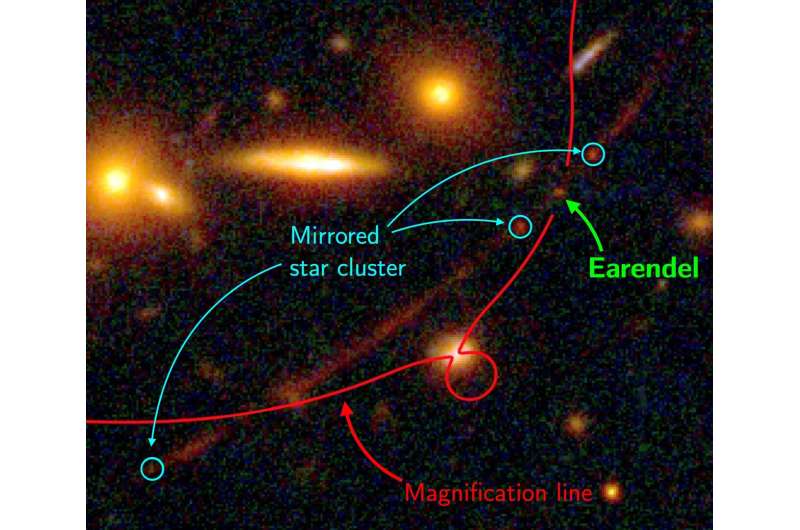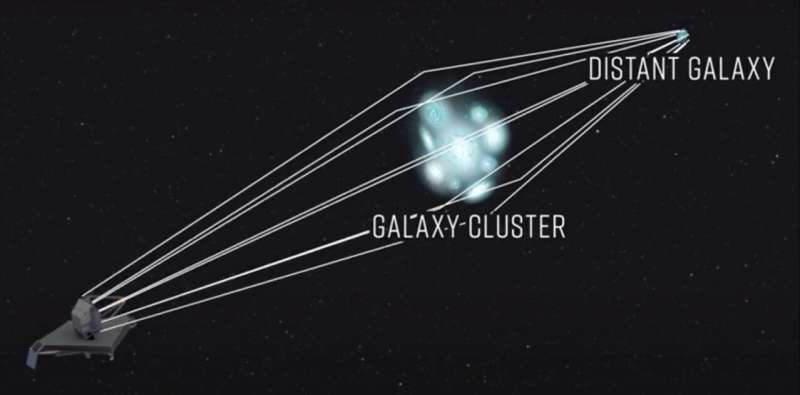
Posted on 03/30/2022 8:24:51 PM PDT by LibWhacker

Closeup of the region on the sky, 1/250 of a degree across, where the gravity of a foreground cluster of galaxies magnifies the distant background star—nicknamed Earendil—thousands of times.
With a fortuitous lineup of a massive cluster of galaxies, astronomers discovered a single star across most of the entire observable Universe. This is the farthest detection of a single star ever. The star may be up to 500 times more massive than the Sun. The discovery has been published today in the journal Nature.
Gazing at the night sky, all the stars that you see lie within our own galaxy, the Milky Way. Even with the most powerful telescopes, under normal circumstances individual stars can only be resolved in our most nearby galactic neighbors. In general, distant galaxies are seen as the blended light from billions of stars.
But with the marvelous natural phenomenon known as "gravitational lensing," astronomers from the Cosmic Dawn Center at the Niels Bohr Institute and DTU Space were nevertheless able to detect a distance where even detecting entire galaxies is challenging.
A cosmic telescope predicted by Einstein
Among the wonders predicted by Einstein's theory of relativity is the ability of mass to "curve" space itself. As light passes close to massive objects, its path follows the curved space and changes direction. If a massive object happens to lie between us and a distant background source of light, the object may deflect and focus the light toward us as a lens, magnifying the intensity.
Galaxies magnified several times are routinely discovered by way of this method. But in an astounding cosmic coincidence, the galaxies in a cluster named WHL0137-08 happened to line up in such a way as to focus the light of a single star toward us, magnifying its light thousands of times.
A combination of this gravitational lens and nine hours of exposure time with the Hubble Space Telescope enabled an international team of astronomers to detect the star.

Close-up of the tiny region where Earendel happened to fall right on top of the narrow line where the magnification increases by (tens of) thousands of times. A cluster of many stars is seen slightly offset from the line, resulting in a much smaller magnification but instead being mirrored by gravity.
Earendel—the morning star
The astronomers nicknamed the star Earendel, from the Old English word meaning "morning star," or "rising light." They calculate that the star it at least 50 times as massive as our Sun, possibly up to 500, and millions of times as bright.
Besides being an astonishing achievement in itself, the observation of Earendel offers a unique possibility of investigating the early Universe:
"As we peer into the cosmos, we also look back in time, so these extreme high-resolution observations allow us to understand the building blocks of some of the very first galaxies," explains Victoria Strait, postdoc at the Cosmic Dawn Center, Copenhagen, and a collaborator and co-author of the study. She elaborates:
"When the light that we see from Earendel was emitted, the Universe was less than a billion years old; only 6% of its current age. At that time it was 4 billion lightyears away from the proto-Milky Way, but during the almost 13 billion years it took the light to reach us, the Universe has expanded so that it is now a staggering 28 billion lightyears away."
The previous record is a star seen when the Universe was around a third of its current age, at which time most of its structure had already formed and evolved. So Earendel is indeed a ground-breaking record.

A massive galaxy cluster focuses and magnifies the light from a background galaxy
A target for the James Webb Space Telescope
To measure the brightness of Earendel, the astronomers constructed a physical model of the gravitational lens. The exact nature of the light source depends on their model, but when the astronomers are so certain that the little dot is in fact a single star, it is in part because many different models all give roughly the same answer.
Nevertheless, Earendel could in principle be more than one star, located very close to each other. To test whether this is the case, the team applied for—and were awarded—observing time with the recently launched James Webb Space Telescope.
"With James Webb, we will be able to confirm that Earendel is indeed just one star, and at the same time quantify which type of star it is," says Sune Toft, leader of the Cosmic Dawn Center and professor at the Niels Bohr Institute, who also participated in the study. "Webb will even allow us to measure its chemical composition. Potentially, Earendel could be the first known example of the Universe's earliest generation of stars."
That’s far out!
Yeah, I’m interested in the answer myself.
That being true, then the light produced would never reach us. The star or body would, in theory, be moving faster than light, therfore, all space beyond a certain point appear void?
It strains credulity - and my patience - to hear some of these astrophysicists bloviate about the universe as they carefully craft their words to avoid violating their sacred pact.
The fact is that nothing will change in our lifetimes, JWST or not, because the hard evidence is a millenia or longer out of reach...if we survive that term.
Earendel has probably gone splodey supernova by now, no? Considering the average lifespan of the typical star? Just a thought.
Oh, yes, long gone by now. I wonder how much time has passed for it? It’s only been 13 billion years for us because that’s all the time we’ve had in this universe so far. Is the same true for that remnant star? Has it aged 28 billion years or only 13 billion years like us? Probably a real dumb question, I know.
I can
First there was nothing and then it exploded.
...But our SUVs are powerful enough to destroy the entire planet.
The science is settled...
The simplest expanding universe to understand is a spherical balloon that is being inflated.
In theory, all points on the balloon are moving away from each other at the same rate of speed. The larger the balloon gets, the faster the dots are moving away from each other.
Locally, several dozen galaxies might remain close because of their mutual pull of gravity.
But, at some point in an expanding universe, every galaxy will eventually drift away from all of its gravitational companions.
There are two other theoretical shapes for our universe.
First, like a megaphone, where the Big Bang takes place where your mouth is and expands forward, infinitely, in a thin, but wider and wider, circle.
Second shape, like a horse saddle, which is a design I do not understand at all.
There does seem to be a broad based astronomical consensus that the universe is flat (or thin, like the thickness of a balloon), but since we can see thousands of light years away, in every direction, just with our eyes, that idea also does not make sense to me.
Possibly because it’s ever-expanding.
Yes, it may have exploded 27.9 billion years ago for all we know
There’s nothing like the universe to bring you down to earth!
I spotted the same damn star off my deck last week with my new contacts... I really like em, they’re pretty clear.
they dont... like most things we see posted today, the “Enhance and Photoshop” speculation as much as they do the images we see.
they*

Two cars are moving 10 mph, directly away from each other. In one hour they are 20 miles away from each other.
Disclaimer: Opinions posted on Free Republic are those of the individual posters and do not necessarily represent the opinion of Free Republic or its management. All materials posted herein are protected by copyright law and the exemption for fair use of copyrighted works.